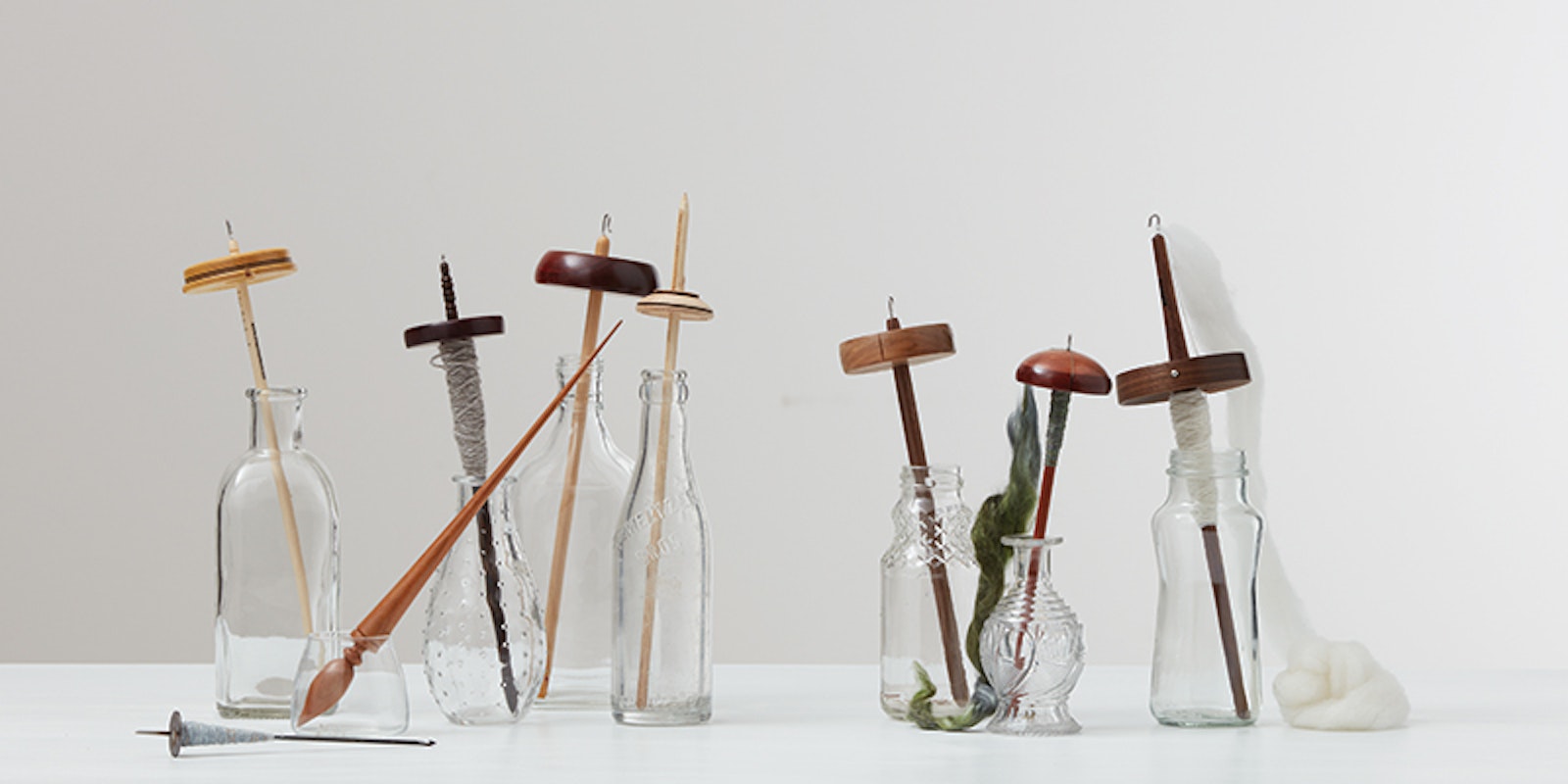It’s no secret—spindles seduce many a spinner. Spindles are the potato chips of the spinning world: you can’t have just one. But don’t judge a spindle by the exotic wood alone! In the Spin Off Spring 2017 article “The Right Spindle for the Job,” Connie Kephart shares her tips for how to pick the right spindle for any project.
I love spindles. I love the materials they’re made of, I love the many hook shapes, and I love the incredible variety of whorls. I confess I often buy spindles based solely on their looks. It has taken me many years, and many failed spindle projects, to learn that I need to look more at the properties of my spindle, my fiber, and the project itself rather than the spindle’s appearance.
 If you want to make silk embroidery thread with high twist and at least 3 plies, I recommend a spindle with a high, center-weighted whorl. When the whorl is made from heavier woods, it helps pull the silk fibers down as the twist is added, for incredibly smooth, tightly spun, shiny singles. Loki spindle, www.greensleevesspindles.com.
If you want to make silk embroidery thread with high twist and at least 3 plies, I recommend a spindle with a high, center-weighted whorl. When the whorl is made from heavier woods, it helps pull the silk fibers down as the twist is added, for incredibly smooth, tightly spun, shiny singles. Loki spindle, www.greensleevesspindles.com.
Unfortunately, picking a spindle and fiber that look really good together just isn’t enough to ensure success (but it’s fun to do when you’re spinning just to spin!). Now when it’s time to spin, I look at my spindles for what they really are: tools. And that’s how you should look at them as well, because no matter how stunning that bloodwood whorl is or how smooth that cherry shaft feels, in the end you want a spindle that will work for you.
When choosing a spindle, I start by asking myself some questions about the whole project.
Do I want a woolen-spun or worsted-spun singles? You might find that long draw works better with a supported spindle, but plenty of people double-draft and spin long draw with a high-whorl or bottom-whorl spindle, so don’t let this answer limit your spindle choice. If I want the most woolen-spun singles I can make, I’ll choose a supported spindle. Anything resembling a worsted-style singles means I’ll use an unsupported (suspended) spindle.
Will my finished yarn be a singles, or am I planning to ply? If I’m planning a two-ply yarn, I’ll use two similar spindles, then ply directly from the spindles.
What weight yarn am I making? There is some truth to the idea that big spindles make big yarn and small spindles make small yarn. I think this is really due to big yarn creating bigger cops and therefore needing a bigger spindle with a longer shaft to hold the bigger cop. The inverse holds for the smaller yarn/smaller spindle. You’ll also hear that a spinner can spin anything on any size spindle, and while it’s true you could, why would you want to do extra work forcing the spindle into a job it isn’t suited for?
 <
If you want to make mittens from a worsted-weight, medium-twist, 3-ply yarn, I recommend a mid-whorl spindle. It has a slight rim for a long, not-too-fast spin and a shaft long enough to easily hold 2 to 3 ounces of singles. Mid-whorl Maggie spindle, www.magpiewoodworksusa.com.
<
If you want to make mittens from a worsted-weight, medium-twist, 3-ply yarn, I recommend a mid-whorl spindle. It has a slight rim for a long, not-too-fast spin and a shaft long enough to easily hold 2 to 3 ounces of singles. Mid-whorl Maggie spindle, www.magpiewoodworksusa.com.
What fiber am I spinning? Do I need a lot of twist or just enough twist to hold the fiber together? If I need lots of twist, I want a fast-spinning spindle that introduces enough twist when paired with my default-drafting rate. If I’m making a low-twist singles, a slower spindle means I can still draft at my default rate, but the spindle (the tool!) introduces less twist.
Am I spinning a lot of fiber or just a small amount? I’m not a fan of knots in my yarn, so I choose a longer shaft to get more yardage per cop.
Where will I be doing my spinning? I rarely consider where I’ll be spinning because I’ll travel with any of my spindles. If you’ll be traveling or spinning wherever and whenever you can, you might want to use a low-whorl spindle with a half hitch so you don’t worry about damaging the hook. (You might also want to save your precious—high-cost or very special—spindles for controlled, carpeted areas to prevent an unfortunate chip or break.)
—Connie
Connie Kephart has been spinning since 2003. She is slightly obsessed with spindles. And fifty-fifty yak/silk top. Learn more of Connie’s tips for picking the best spindle for the job in the _ Spin Off_ Spring 2017 issue!
Featured Image: What’s the best spindle for the job? Featured spindles left to right: tahkli, www.cottonclouds.com; rim-weighted True Creations spindle, www.tcspindles.com; Russian spindle, www.grippingyarn.com; evenly weighted SpindleWood spindle, www.spindlewoodco.com; Bosworth rim-weighted Midi spindle, www.journeywheel.com; low-whorl Peruvian spindle, www.clothroads.com; high-whorl Bare Bones spindle, www.greensleevesspindles.com; Loki spindle, www.greensleevesspindles.com; mid-whorl Maggie spindle, www.magpiewoodworksusa.com. Photos by George Boe.

